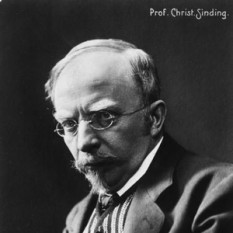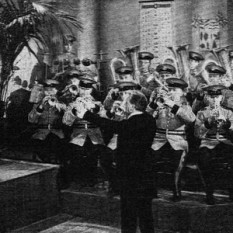Ronald Binge (July 15, 1910, Derby – September 6, 1979, Ringwood, Hampshire) was a British composer and arranger of light music.
Life
Ronald Binge was born in a working-class neighbourhood in Derby in the English Midlands. In his early life he was a cinema organist and later started working in summer orchestras in British seaside resorts, for which he learned to play the piano accordion. His skill as a cinema organist was put to good use, and he played the latter instrument in Mantovani's first band, the Tipica Orchestra. During the Second World War, Binge served in the Royal Air Force, during which time he was much in demand organising camp entertainment.
After the end of the war, Mantovani offered him the job of arranging and composing for his new orchestra. In 1951, his arrangement of "Charmaine"" gave him and Mantovani worldwide success and recognition. However, he later tired of writing arrangements and turned to composing original works and film scores.
He died of liver cancer in 1979, aged 69.
Works
Binge was interested in the technicalities of composition and was most famous as the inventor of the "cascading strings" effect which is the signature sound of the Mantovani orchestra, much used in their arrangements of popular music. It was originally created to capture the essence of the echo properties of a building such as a cathedral, although it later became particularly associated with easy listening music genre.
His best known compositions are "Elizabethan Serenade" (1951), which was used by the British Broadcasting Corporation as the theme for the popular 1950s series, "Music Tapestry," and as the play-out for the British Forces Network radio station, for which he won an Ivor Novello Award, and "Sailing By" (1963), the BBC Radio 4 Shipping Forecast theme. Other well-known pieces include "Miss Melanie", "The Watermill" (1958)," and his Concerto for Alto Saxophone in E flat major" (1956).
Less well-known is a piano piece known as "Vice Versa", a musical palindrome which was not only a front-to-back palindrome, but also exploited the two staves used for writing for piano. The music reads the same, whatever way it is turned. He later extended this theme, composing a piece known as "Upside/Downside" for his son, who was learning to play the recorder at Downside School. This musical palindrome was for piano, recorder and cello and again was universally reversible - two players could therefore play from the same sheet of music reading from opposite ends. .
You can find information through the best music search engine - Muzlan.top 😊All materials on request "Ronald Binge" are available on page Ronald Binge
Yes of course. You can listen tracks on the page Ronald Binge
Yes of course. You can download tracks on the page Ronald Binge
This page is found by queries: Ronald Binge song download, Ronald Binge all mp3, Ronald Binge track minus, Ronald Binge song listen, Ronald Binge flac




